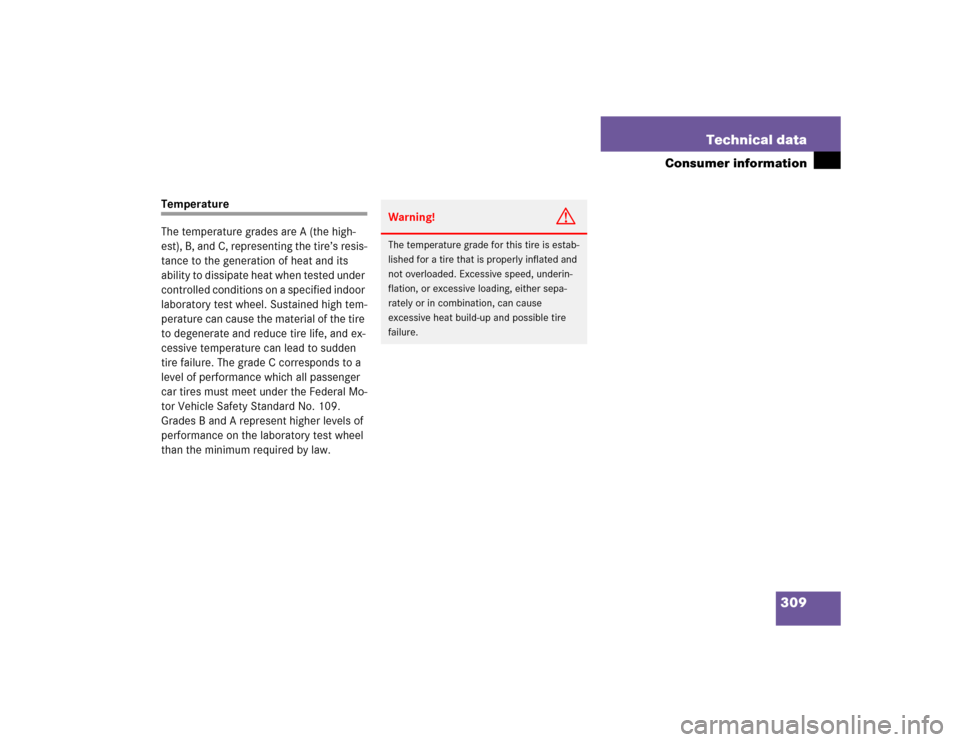Page 305 of 344
305 Technical data
Fuels, coolants, lubricants etc.
Anticorrosion / antifreeze
Your vehicle contains a number of alumi-
num parts. The use of aluminum compo-
nents in motor vehicle engines
necessitates that
anticorrosion / antifreeze coolant used in
such engines be specifically formulated to
protect the aluminum parts. (Failure to use
such anticorrosion / antifreeze coolant will
result in a significantly shortened service
life.)
Therefore, the following product is strongly
recommended for use in your vehicle:
Mercedes-Benz Anticorrosion / Antifreeze
agent.
Before the start of the winter season (or
once a year in hot southern regions), you
should have the anticorrosion / antifreeze
concentration checked. The coolant is also
regularly checked each time you bring your
vehicle to your authorized Mercedes-Benz
Light Truck Center for service.
Page 306 of 344
306 Technical dataFuels, coolants, lubricants etc.Anticorrosion / antifreeze quantityModel
Approx. freeze protection– 35°F (– 37°C)
– 49°F (– 45°C)
ML 350, ML 500,
6.4 US qt (6.0 l)
7.0 US qt (6.6 l)
Page 307 of 344

307 Technical data
Fuels, coolants, lubricants etc.
Windshield washer system and headlamp cleaning system*
Both the windshield washer and headlamp
cleaning system* are supplied from the
windshield washer fluid reservoir.
The windshield and headlamp washer fluid
reservoir has a capacity of approx.
8.0 US qt (7.6 l).�
Refill the reservoir with MB Windshield
Washer Concentrate “S” and water (or
concentrate and commercially avail-
able premixed windshield washer
solvent / antifreeze, depending on am-
bient temperatures).Windshield and headlamp washer fluid
mixing ratio
For temperatures above freezing, use
MB Windshield Washer Concentrate “S”
and water:�
1 part “S” to 100 parts water
[40 ml “S” to 1 gallon (4 liters) water].
For temperatures below freezing, use
MB Windshield Washer Concentrate “S”
and commercially available premixed
windshield washer solvent / antifreeze:
�
1part “S” to 100parts solvent
[40 ml “S” to 1 gallon (4 liters) solvent].
Warning!
G
Washer solvent / antifreeze is highly flam-
mable. Do not spill washer
solvent / antifreeze on hot engine parts, be-
cause it may ignite and burn. You could be
seriously burned.
Page 308 of 344

308 Technical dataConsumer information
�Consumer informationThis has been prepared as required of all
manufacturers of passenger cars under
Title 49, Code of U.S. Federal Regulations,
Part 575 pursuant to the “National Traffic
and Motor Vehicle Safety Act of 1966”.Uniform tire quality grading
Quality grades can be found, where appli-
cable, on the tire sidewall between tread
shoulder and maximum section width. For
example:
All passenger car tires must conform to
federal safety requirements in addition to
these grades.Tread wear
The tread wear grade is a comparative rat-
ing based on the wear rate of the tire when
tested under controlled conditions on a
specified government test course. For ex-
ample, a tire graded 150 would wear one
and one-half (1½) times as well on the gov-
ernment course as a tire graded 100. The
relative performance of tires depends
upon the actual conditions of their use,
however, and may depart significantly
from the norm due to variations in driving
habits, service practices and differences in
road characteristics and climate.Traction
The traction grades, from highest to lowest
are AA, A, B, and C. Those grades repre-
sent the tire’s ability to stop on wet pave-
ment as measured under controlled
conditions on specified government test
surfaces of asphalt and concrete. A tire
marked C may have poor traction perfor-
mance.Tread wear
Traction
Temperature
200
AA
A
Warning!
G
The traction grade assigned to this tire is
based on straightahead braking traction
tests, and does not include acceleration,
cornering, hydroplaning, or peak traction
characteristics.
Page 309 of 344

309 Technical data
Consumer information
Temperature
The temperature grades are A (the high-
est), B, and C, representing the tire’s resis-
tance to the generation of heat and its
ability to dissipate heat when tested under
controlled conditions on a specified indoor
laboratory test wheel. Sustained high tem-
perature can cause the material of the tire
to degenerate and reduce tire life, and ex-
cessive temperature can lead to sudden
tire failure. The grade C corresponds to a
level of performance which all passenger
car tires must meet under the Federal Mo-
tor Vehicle Safety Standard No. 109.
Grades B and A represent higher levels of
performance on the laboratory test wheel
than the minimum required by law.
Warning!
G
The temperature grade for this tire is estab-
lished for a tire that is properly inflated and
not overloaded. Excessive speed, underin-
flation, or excessive loading, either sepa-
rately or in combination, can cause
excessive heat build-up and possible tire
failure.
Page 311 of 344

311 Technical terms
ABS
(A
ntilock B
rake S
ystem)
Prevents the wheels from locking up
during braking so that the vehicle can
continue to be steered.
BabySmart
TM airbag deactivation
system
This system detects if a special system
compatible child restraint seat is in-
stalled on the front passenger seat. The
system will automatically deactivate
the passenger front airbag when such a
seat is properly installed (indicator
lamp7 in the instrument cluster
lights up). See your authorized
Mercedes-Benz Light Truck Center for
availability.
BabySmartTM compatible child seats
Special restraint system for children.
The sensor system for the passenger
seat prevents deployment of the pas-
senger front airbag if a BabySmart
TM
compatible child seat is installed.BAS
(B
rake A
ssist S
ystem)
System for potentially reducing braking
distances in emergency braking situa-
tions. The system is activated when it
senses an emergency based on how
fast the brake is applied.
Bi-Xenon headlamps*
Headlamps which use an electric arc as
the light source and produce a more in-
tense light than filament headlamps.
Bi-Xenon headlamps produce low
beam and high beam.
CAC
(C
ustomer A
ssistance C
enter)
Mercedes-Benz customer service cen-
ter, which can help you with any ques-
tions about your vehicle and provide
assistance in the event of a break-
down.CAN system
(C
ontroller A
rea N
etwork)
Data bus network serving to control ve-
hicle functions such as door locking or
windshield wiping.
Cockpit
All instruments, switches, buttons and
indicator / warning lamps in the pas-
senger compartment needed for vehi-
cle operation and monitoring.
Cruise control
Driving convenience system for auto-
matically maintaining the vehicle speed
set by the driver.
Engine number
The number set by the manufacturer
and placed on the cylinder block to
uniquely identify each engine pro-
duced.
Page 314 of 344

314 Technical termsPoly-V-belt drive
Drives engine-components (alternator,
AC compressor, etc.) from the engine.
Power train
Collective term designating all compo-
nents used to generate and transmit
motive power to the drive axles, includ-
ing
�
engine
�
clutch / torque converter
�
transmission
�
transfer case
�
drive shaft
�
differential
�
axle shafts / axlesRemote Vehicle Diagnostics
Transmission of vehicle data and cur-
rent location to the Mercedes-Benz
Customer Assistance Center for sub-
scribers to Tele Aid service.
REST
(Residual engine heat utilization)
Feature that uses the engine heat
stored in the coolant to heat the vehi-
cle interior for a short time after the en-
gine has been turned off.
Restraint system
Seat belts, belt tensioner, airbags and
child seat restraint systems. As inde-
pendent systems, their protective func-
tions complement one another.RON
(R
esearch O
ctane N
umber)
The Research Octane Number for gaso-
line as determined by a standardized
method. It is an indication of a gaso-
line's ability to resist undesired detona-
tion (knocking). The average of both
the ->MON (Motor Octane Number)
and RON (Research Octane Number) is
posted at the pump, also known as
ANTI-KNOCK INDEX.
Shift lock
When the vehicle is parked, this lock
prevents the transmission selector le-
ver from being moved out of positionP
without key turned and brake pedal de-
pressed.
SRS
(S
upplemental R
estraint S
ystem)
Seat belts, emergency tensioning de-
vice and airbags. Though independent
systems, they are closely interfaced to
provide effective occupant protection.
Page 323 of 344

323 Index
Display messages
Error 256
Service indicator (FSS) 256
StArt 256
Displays
Messages 219
Service indicator 232
Distance remaining 189
Door entry lamps 113
Door unlock
With Tele Aid* 179
Doors
Opening from inside vehicle 90
Opening from outside 89
Downhill driving
Cruise control 151
Downshifting 120
Drink holder see Cup holder 167
Drinking and driving 193Driving 42, 47
Abroad 211
In winter 198
Problems 51
Safety systems 76
Through standing water 200
Driving abroad 211
Driving instructions
Towing a trailer 209
Driving off 195
Driving safety systems
4-ETS 79
ABS 76
BAS 78
ESP 80
Driving systems 150
Cruise control 150
Driving safety systems 76
EBP 80
Parktronic* 153
Driving through water 203E
Easy entry/exit feature* 101
EBP 80
Indicator lamp 245
Economy mode
Automatic climate control 135
Electrical connections
Trailer 207
Electrical fuses 287
Electrical outlet 170
Electrical system
Technical data 297
Electrically folding exterior rear view
mirrors 128
Electronic Brake Proportioning see EBP
Electronic Stability Program see ESP 25,
80
Electronic stability program see ESP 312
Electronic Traction System see 4-ETS 25
Emergency call system
Requirements 172
Emergency call system* 172